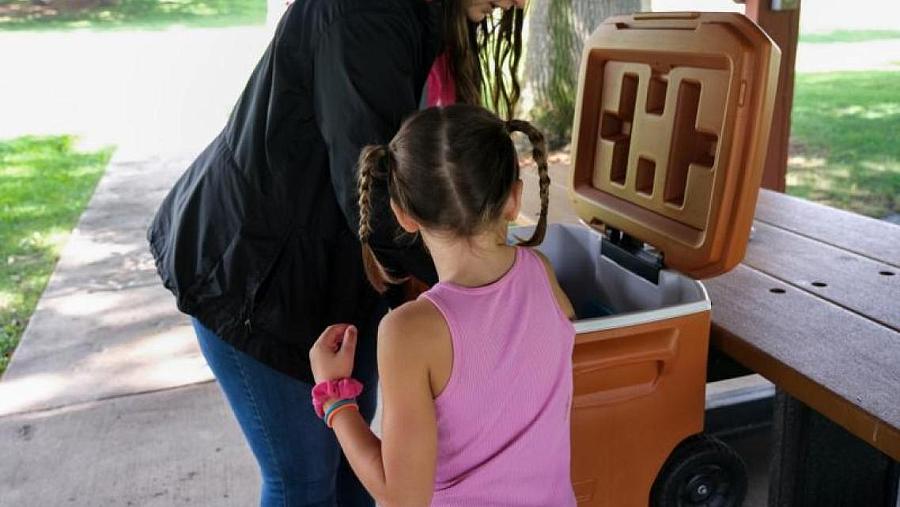These temporary pandemic actions could have permanently lowered food insecurity in kids

Erin McAlvany’s family receives meals at a meal site in Kirksville, Missouri.
Arin Yoon/NBC News
The staff members standing underneath the August sun were getting antsy. Inside their bright orange coolers were dozens of free meals for children. But hardly any kids had stopped by.
The lack of attendees at the summer meals site that I visited in Kirksville, Missouri, did not reflect a lack of need: over 60% of children in the rural community qualify for free or reduced-price lunch. So why had so few families shown up?
My fellowship project focused on child hunger and the provisions instituted to prevent food insecurity from skyrocketing during the pandemic. I was examining what happened as the federal government ended these provisions, which expired at a time of record high inflation and soaring grocery prices.
While the measures were never intended to be permanent, they were enormously successful. They allowed every school cafeteria to serve free meals to K-12 students regardless of their families’ income. They also provided much-needed flexibility to the Summer Food Service Program, which serves free meals and snacks at sites throughout the country to low-income children during what is often their hungriest time of year.
While lauded by anti-hunger advocates, the federally funded, state-administered Summer Food Service Program has also faced criticism.
Prior to the pandemic, it required that children sit and eat at locations where meals were being distributed during specific times. Advocates have argued that lack of access to transportation, scheduling conflicts and other barriers meant that with those stringent requirements, six out of seven kids who may have needed summer meals were missing out.
The pandemic-era child nutrition waivers changed that. Meal site operators were permitted to distribute “grab-and-go” meals that parents could bring home to their kids. Program operators were also allowed to bundle multiple days’ worth of meals, saving parents trips back and forth.
The loosened restrictions were not expected to continue past June 2022, but eleventh-hour congressional action allowed states to opt back into them for one final summer. I reached out to all 50 states to find out whether they had opted into the extended waiver and discovered that just one had not: Missouri.
On the day I visited the meal site in Kirksville, a father drove up. His children were regulars there, but on this day, he was by himself.
He pulled up to the orange coolers and politely asked for some meals to bring to his kids. The staff apologized and explained to him that the rules had changed since the summer prior. They asked if he could come back with his children so they could be served there.
Forty-five minutes passed with no sign of the kids and the staff reluctantly began collecting their coolers. If they stayed even a few minutes after the site closed, they told me, they could risk getting penalized by the USDA.
An alarming preview of future summers
The meal sites in Missouri provided a perfect — and alarming — preview of summers to come.
One program director in a rural part of the state said he was serving 97% fewer summer meals without the grab-and-go option. Conversations with other Missouri summer meal program operators revealed similar plunges in meals distributed.
Missouri officials told me that they chose not to allow grab-and-go summer meals because they felt food taken off-site compromised the “integrity” of the Summer Food Service Program. The program operators disagreed. They told me how they would often see parents pick up meals and watch kids devour the food before their cars had even driven away.
In addition to writing about the summer meals program, I also wrote about the end of universal school meals and the growing number of families who can’t afford to pay for lunch, yet are outside of the narrow income band to qualify for free or reduced-price meals.
As the third part of my project, I examined the absurd rule that prevents reimbursement for most victims of SNAP “skimming,” a type of electronic theft of food stamps that is on the rise.
I learned so much from this project. Even before COVID-19 hit, about one in six children in the U.S. was at risk of hunger, according to Feeding America. Hearing about how the end of the federal child nutrition waivers affected families was heartbreaking and infuriating.
A few tips to share:
Contrasting the state-by-state differences in how federally funded programs are run can yield a lot of stories. USDA does not have a master list in many cases that compares how each state handles their programs, and the officials there were as surprised as I was to learn Missouri was an outlier in the summer meals program.
There is huge reader interest in the subject of child hunger — yet not a ton of coverage of it.
Earning the trust of a family who is willing to speak publicly about their finances requires time and patience. I am so grateful to the sources I spoke to; I feel that their stories will shape policies in the future.
Finally, I learned that this is an issue that demands continued attention. It shouldn’t take one crisis to address another, and yet, it wasn’t until the pandemic hit that solutions to reducing child food insecurity were implemented. We need to do everything we can to make sure lasting solutions are put into place.

